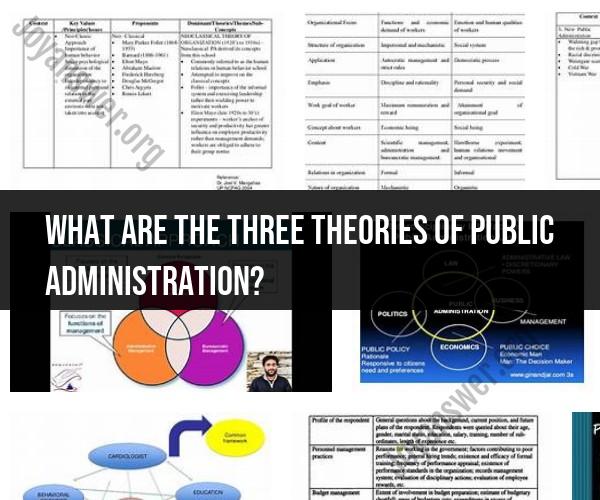What are the three theories of Public Administration?
Public Administration, as a field of study, has evolved over time, leading to the development of various theories and approaches. Three significant theories of Public Administration include Classical, Neoclassical, and Modern theories. Each theory reflects distinct perspectives on the role and function of public administration in government and society:
1. Classical Theory of Public Administration:
- Key Thinkers: Frederick W. Taylor, Max Weber, and Henri Fayol.
- Time Period: Late 19th to early 20th century.
- Characteristics:
- Emphasizes principles of scientific management, bureaucracy, and hierarchical organization.
- Focuses on efficiency, division of labor, and a clear chain of command.
- Bureaucracy is seen as a rational and efficient way to organize and manage public institutions.
- Weber's concept of the "ideal type" bureaucracy emphasizes formal rules, impersonal relationships, and merit-based hiring.
- Contributions:
- Classical theory laid the groundwork for principles of administrative management and organizational structure.
- Introduced the idea of specialization, which can enhance efficiency in public organizations.
- Critiques:
- Critics argue that classical theory can lead to excessive bureaucracy and dehumanization of public administration.
- It may not address the need for adaptability and responsiveness in modern government.
2. Neoclassical Theory of Public Administration:
- Key Thinkers: Herbert A. Simon, Dwight Waldo, and Chester I. Barnard.
- Time Period: Mid-20th century.
- Characteristics:
- Incorporates insights from the behavioral sciences, psychology, and sociology into the study of public administration.
- Focuses on human behavior, decision-making, and organizational behavior within public organizations.
- Emphasizes the limitations of rationality and the importance of administrative discretion.
- Contributions:
- Highlighted the importance of understanding human behavior and the social context in which public administration operates.
- Introduced concepts like bounded rationality, satisficing (making decisions that are "good enough"), and the informal organization.
- Critiques:
- Critics argue that neoclassical theory may not provide clear guidance for organizational design and management practices.
- Some aspects of human behavior and organizational behavior remain difficult to predict and manage.
3. Modern Theory of Public Administration:
- Key Thinkers: Fred W. Riggs, Ferrel Heady, and Robert T. Golembiewski.
- Time Period: Late 20th century to the present.
- Characteristics:
- Reflects a more dynamic and context-sensitive approach to public administration.
- Acknowledges the diversity of administrative systems and practices around the world.
- Focuses on issues like public sector reform, governance, and the role of public administration in addressing complex societal challenges.
- Contributions:
- Modern theory emphasizes the need for adaptability, innovation, and responsiveness in public administration.
- Addresses the challenges of globalization, technology, and the changing expectations of citizens.
- Critiques:
- Critics argue that modern theory may lack a unified framework and may not offer clear solutions to the complex issues faced by public administrators.
- The context-sensitive nature of modern theory makes it challenging to develop universal principles.
These three theories of Public Administration provide historical and conceptual foundations for understanding the evolution of administrative thought and practice. In contemporary public administration, elements from all three theories may be integrated to address the multifaceted challenges of public governance in an ever-changing world.


